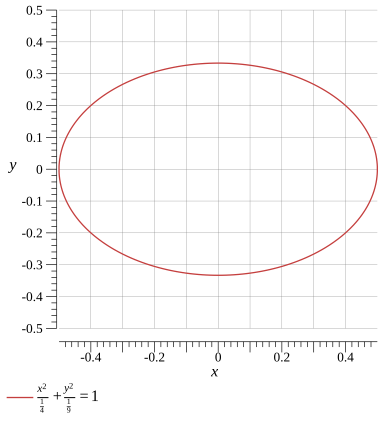Question
Identify the conic
Find the standard equation of the ellipse
Find the center of the ellipse
Find the foci of the ellipse
Load more

41x2+91y2=1
Evaluate
x2×4+y2×9=1
Simplify
More Steps


Evaluate
x2×4+y2×9
Use the commutative property to reorder the terms
4x2+y2×9
Use the commutative property to reorder the terms
4x2+9y2
4x2+9y2=1
Use a=a11 to transform the expression
41x2+9y2=1
Solution
41x2+91y2=1
Show Solution

Solve the equation
Solve for x
Solve for y
x=21−9y2x=−21−9y2
Evaluate
x2×4+y2×9=1
Simplify
More Steps


Evaluate
x2×4+y2×9
Use the commutative property to reorder the terms
4x2+y2×9
Use the commutative property to reorder the terms
4x2+9y2
4x2+9y2=1
Move the expression to the right-hand side and change its sign
4x2=1−9y2
Divide both sides
44x2=41−9y2
Divide the numbers
x2=41−9y2
Take the root of both sides of the equation and remember to use both positive and negative roots
x=±41−9y2
Simplify the expression
More Steps


Evaluate
41−9y2
To take a root of a fraction,take the root of the numerator and denominator separately
41−9y2
Simplify the radical expression
More Steps


Evaluate
4
Write the number in exponential form with the base of 2
22
Reduce the index of the radical and exponent with 2
2
21−9y2
x=±21−9y2
Solution
x=21−9y2x=−21−9y2
Show Solution

Testing for symmetry
Testing for symmetry about the origin
Testing for symmetry about the x-axis
Testing for symmetry about the y-axis
Symmetry with respect to the origin
Evaluate
x24+y29=1
Simplify the expression
4x2+9y2=1
To test if the graph of x24+y29=1 is symmetry with respect to the origin,substitute -x for x and -y for y
4(−x)2+9(−y)2=1
Evaluate
More Steps


Evaluate
4(−x)2+9(−y)2
Multiply the terms
4x2+9(−y)2
Multiply the terms
4x2+9y2
4x2+9y2=1
Solution
Symmetry with respect to the origin
Show Solution

Find the first derivative
Find the derivative with respect to x
Find the derivative with respect to y
dxdy=−9y4x
Calculate
x24+y29=1
Simplify the expression
4x2+9y2=1
Take the derivative of both sides
dxd(4x2+9y2)=dxd(1)
Calculate the derivative
More Steps


Evaluate
dxd(4x2+9y2)
Use differentiation rules
dxd(4x2)+dxd(9y2)
Evaluate the derivative
More Steps


Evaluate
dxd(4x2)
Use differentiation rule dxd(cf(x))=c×dxd(f(x))
4×dxd(x2)
Use dxdxn=nxn−1 to find derivative
4×2x
Multiply the terms
8x
8x+dxd(9y2)
Evaluate the derivative
More Steps


Evaluate
dxd(9y2)
Use differentiation rules
dyd(9y2)×dxdy
Evaluate the derivative
18ydxdy
8x+18ydxdy
8x+18ydxdy=dxd(1)
Calculate the derivative
8x+18ydxdy=0
Move the expression to the right-hand side and change its sign
18ydxdy=0−8x
Removing 0 doesn't change the value,so remove it from the expression
18ydxdy=−8x
Divide both sides
18y18ydxdy=18y−8x
Divide the numbers
dxdy=18y−8x
Solution
More Steps


Evaluate
18y−8x
Cancel out the common factor 2
9y−4x
Use b−a=−ba=−ba to rewrite the fraction
−9y4x
dxdy=−9y4x
Show Solution

Find the second derivative
Find the second derivative with respect to x
Find the second derivative with respect to y
dx2d2y=−81y336y2+16x2
Calculate
x24+y29=1
Simplify the expression
4x2+9y2=1
Take the derivative of both sides
dxd(4x2+9y2)=dxd(1)
Calculate the derivative
More Steps


Evaluate
dxd(4x2+9y2)
Use differentiation rules
dxd(4x2)+dxd(9y2)
Evaluate the derivative
More Steps


Evaluate
dxd(4x2)
Use differentiation rule dxd(cf(x))=c×dxd(f(x))
4×dxd(x2)
Use dxdxn=nxn−1 to find derivative
4×2x
Multiply the terms
8x
8x+dxd(9y2)
Evaluate the derivative
More Steps


Evaluate
dxd(9y2)
Use differentiation rules
dyd(9y2)×dxdy
Evaluate the derivative
18ydxdy
8x+18ydxdy
8x+18ydxdy=dxd(1)
Calculate the derivative
8x+18ydxdy=0
Move the expression to the right-hand side and change its sign
18ydxdy=0−8x
Removing 0 doesn't change the value,so remove it from the expression
18ydxdy=−8x
Divide both sides
18y18ydxdy=18y−8x
Divide the numbers
dxdy=18y−8x
Divide the numbers
More Steps


Evaluate
18y−8x
Cancel out the common factor 2
9y−4x
Use b−a=−ba=−ba to rewrite the fraction
−9y4x
dxdy=−9y4x
Take the derivative of both sides
dxd(dxdy)=dxd(−9y4x)
Calculate the derivative
dx2d2y=dxd(−9y4x)
Use differentiation rules
dx2d2y=−(9y)2dxd(4x)×9y−4x×dxd(9y)
Calculate the derivative
More Steps


Evaluate
dxd(4x)
Simplify
4×dxd(x)
Rewrite the expression
4×1
Any expression multiplied by 1 remains the same
4
dx2d2y=−(9y)24×9y−4x×dxd(9y)
Calculate the derivative
More Steps


Evaluate
dxd(9y)
Simplify
9×dxd(y)
Calculate
9dxdy
dx2d2y=−(9y)24×9y−4x×9dxdy
Calculate
dx2d2y=−(9y)236y−4x×9dxdy
Calculate
dx2d2y=−(9y)236y−36xdxdy
Calculate
More Steps


Evaluate
(9y)2
Evaluate the power
92y2
Evaluate the power
81y2
dx2d2y=−81y236y−36xdxdy
Calculate
dx2d2y=−9y24y−4xdxdy
Use equation dxdy=−9y4x to substitute
dx2d2y=−9y24y−4x(−9y4x)
Solution
More Steps


Calculate
−9y24y−4x(−9y4x)
Multiply
More Steps


Multiply the terms
4x(−9y4x)
Any expression multiplied by 1 remains the same
−4x×9y4x
Multiply the terms
−9y16x2
−9y24y−(−9y16x2)
Subtract the terms
More Steps


Simplify
4y−(−9y16x2)
If a negative sign or a subtraction symbol appears outside parentheses, remove the parentheses and change the sign of every term within the parentheses
4y+9y16x2
Reduce fractions to a common denominator
9y4y×9y+9y16x2
Write all numerators above the common denominator
9y4y×9y+16x2
Multiply the terms
9y36y2+16x2
−9y29y36y2+16x2
Divide the terms
More Steps


Evaluate
9y29y36y2+16x2
Multiply by the reciprocal
9y36y2+16x2×9y21
Multiply the terms
9y×9y236y2+16x2
Multiply the terms
81y336y2+16x2
−81y336y2+16x2
dx2d2y=−81y336y2+16x2
Show Solution

Rewrite the equation
r=4+5sin2(θ)4+5sin2(θ)r=−4+5sin2(θ)4+5sin2(θ)
Evaluate
x2×4+y2×9=1
Evaluate
More Steps


Evaluate
x2×4+y2×9
Use the commutative property to reorder the terms
4x2+y2×9
Use the commutative property to reorder the terms
4x2+9y2
4x2+9y2=1
To convert the equation to polar coordinates,substitute x for rcos(θ) and y for rsin(θ)
4(cos(θ)×r)2+9(sin(θ)×r)2=1
Factor the expression
(4cos2(θ)+9sin2(θ))r2=1
Simplify the expression
(4+5sin2(θ))r2=1
Divide the terms
r2=4+5sin2(θ)1
Evaluate the power
r=±4+5sin2(θ)1
Simplify the expression
More Steps


Evaluate
4+5sin2(θ)1
To take a root of a fraction,take the root of the numerator and denominator separately
4+5sin2(θ)1
Multiply by the Conjugate
4+5sin2(θ)×4+5sin2(θ)1×4+5sin2(θ)
Calculate
4+5sin2(θ)1×4+5sin2(θ)
Any expression multiplied by 1 remains the same
4+5sin2(θ)4+5sin2(θ)
r=±4+5sin2(θ)4+5sin2(θ)
Solution
r=4+5sin2(θ)4+5sin2(θ)r=−4+5sin2(θ)4+5sin2(θ)
Show Solution

Graph
